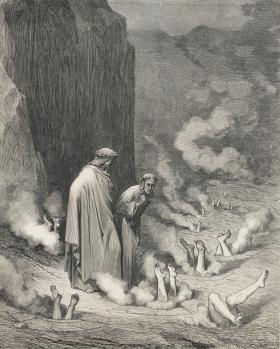The divine Dante
Abandon all hope, ye who enter here.— Dante Alighieri, The Divine Comedy, 1320
The great Italian poet Dante Alighieri died in Ravenna, in northern Italy, in 1321. Seven hundred years later, the literary world is joining Italy in commemorating the life of a writer who is considered the father of the Italian language because he chose to write in vernacular Tuscan rather than Latin.
Written in the first person, Dante’s masterpiece The Divine Comedy — completed in the year before his death — follows the narrator’s progress through the three realms of the afterlife: hell, purgatory and finally paradise. In the nine circles of hell he finds adulterous lovers buffeted by the winds of passion, eternally clasping each other, and thieves with their hands cut off, their bodies entwined with serpents. As he descends from circle to circle, the sinners become increasingly spiteful, murderous and traitorous. Finally, at the centre of the earth, Satan takes each of the greatest sinners in one of his three mouths and eats them.
Throughout the work’s 100 sections, or cantos, Dante’s commentary on human traits and failings — on love, jealousy, greed, theft and the politics of his day — can easily be related to our world today. His ability to evoke an almost universal story has ensured the enduring popularity of his writing.
Dante’s work has also profoundly influenced artists, inspiring Botticelli and Blake, Delacroix, Dalí and Doré. His ideas and imagery have found their way into films, novels, music, mobile apps and video games.
Among many English translations, Australian author and critic Clive James’ version was published in 2013. He described The Divine Comedy as a poem of almost unparalleled power — ‘a vast act of illumination’.
Maggie Patton, Rare Books & Maps expert
This story appears in Openbook Autumn 2021.
